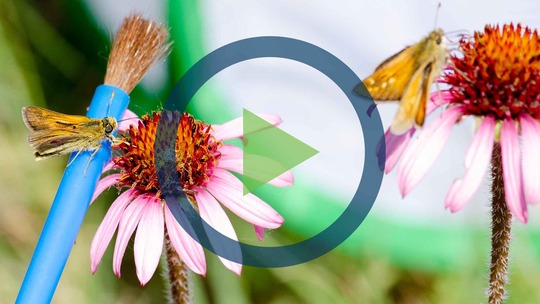 Video of Dakota skipper butterflies reintroduced at Glacial Lakes State Park.
The Minnesota Department of Natural Resources recently released a year-end of list of some of its major accomplishments from 2023.
From supporting the return of rare species and connecting more people to the outdoors, to conserving and managing the state’s natural resources, the DNR made significant advances toward the mission and priorities laid out in the agency’s strategic plan.
"I am so proud of all that Minnesota DNR accomplished in 2023 and how that work benefits conservation and outdoor recreation in Minnesota as well as the health of people, the environment and the economy," DNR Commissioner Sarah Strommen said. "These accomplishments illustrate the scope, breadth, and depth of the DNR’s work on behalf of Minnesotans."
To support the DNR’s work in 2023 and beyond, the transformative Get Out MORE (Modernize Outdoor Recreation Experiences) initiative was included in Gov. Tim Walz and Lt. Gov. Peggy Flanagan’s 2023 One Minnesota Budget. The $150 million will enhance access and welcome new users to the outdoors, revitalize camping and related infrastructure, enhance fishing opportunities, modernize boating access, and update other water-related infrastructure.
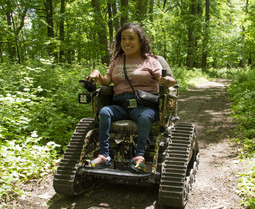
One example of how the new Get Out MORE funding enhanced accessibility is the expansion of the DNR’s all-terrain track chair program. As of fall 2023, there were 13 all-terrain track chairs available at state parks across Minnesota.
The funding also helped bolster projects like the replacement of the Drayton Dam with a rock arch rapids. The Drayton Dam was the last and largest of the Red River’s low head dams and the removal and replacement work allows fish passage, addresses public safety concerns, and enhances water recreation activities. This historic milestone represents the culmination of 30 years of work by the DNR and its partners.
Another accomplishment made by the DNR was its work to mitigate and adapt to climate change. Through the Get Out MORE initiative, the DNR planted 2,000 bur oaks in Nerstrand-Big Woods State Park to help address the effects of increased rainfall events caused by climate change.
Also in 2023, the DNR stocked heritage native brook trout fingerlings in 14 southeastern Minnesota streams and reintroduced Dakota skipper butterflies to the prairie at Glacial Lakes State Park in partnership with the Minnesota Zoo.
These are just a few highlights from the DNR’s 2023 accomplishments. To see a more complete list, visit the DNR website.
|

To support and enhance diversity, equity, and inclusion as a core value of the department, the DNR's Office of Diversity, Equity, and Inclusion invites staff to the upcoming virtual DEI Synergy Symposiums, where staff will highlight the progress and impact of DEI work at the DNR.
These events aim to create a shared understanding of the goals and objectives of the programs within the ODEI, discuss DEI initiatives throughout the agency, share successes and opportunities related to DEI, and improve staff awareness of DEI priorities.
|
ODEI will offer three event options.
All DNR staff and leadership are required to attend at least one of the events below.
Friday, Jan. 5 from 1-2:30 p.m.
Thursday, Jan. 11 from 11 a.m. to 12:30 p.m.
Tuesday, Jan. 23 from 1:30-3 p.m.
CART captioning will be provided.
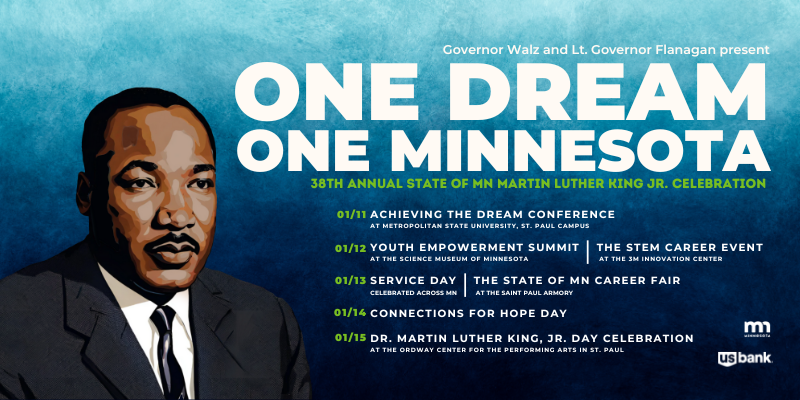
On behalf of the Governor’s Council on the Martin Luther King, Jr. Holiday, you are invited to celebrate the life and legacy of Dr. Martin Luther King, Jr. on Jan. 11-15.
The multi-day celebration will provide opportunities for all Minnesotans to experience One Dream, One Minnesota in a variety of ways:
- Thursday, Jan. 11 – Achieving the Dream Conference for equity practitioners at Metropolitan State University, St. Paul campus, 11 a.m. – 3:30 p.m., registration required.
- Friday, Jan. 12 – Youth Empowerment Summit at the Science Museum of Minnesota and STEM Career Event at the 3M Innovation Center, for high school students, 10 a.m. – 1 p.m.
- Saturday, Jan. 13 – Gathering for service (various locations across Minnesota) and state of Minnesota Career Fair at the National Guard Armory in Saint Paul, 10 a.m. – 2 p.m.
- Sunday, Jan. 14 – Connections for Hope (various locations across Minnesota).
- Monday, Jan. 15 – 38th Annual Martin Luther King, Jr. Holiday celebration hosted by Gov. Walz and Lt. Gov. Flanagan at the Ordway Center for the Performing Arts in St. Paul, free and open to the public, 10:30 a.m. – 12:30 p.m.
Event details can be found on the Office of Equity, Opportunity, and Accessibility website and on the State of Minnesota Governor’s Council on the MLK Day Celebration Facebook page.
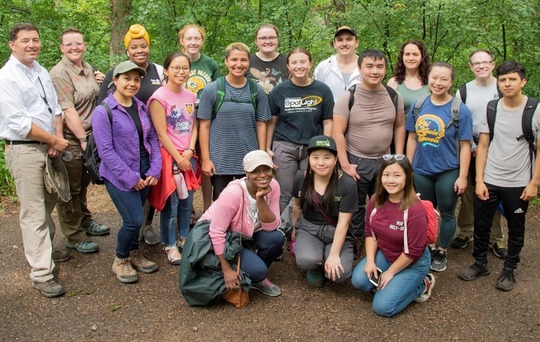 Photo of group at Afton State Park from a recent IDEC Cohort.
IDEC is a career pathways program and strategic partnership between the Minnesota Department of Natural Resources, Conservation Corps Minnesota and Iowa (CCMI), Minnesota Pollution Control Agency, and the Minnesota Board of Water and Soil Resources.
The IDEC program is offering a 10-week paid summer rotational internship for underrepresented college freshmen students including women, racial/ethnic minorities, and individuals with disabilities that are interested in learning about environmental and natural resource conservation careers. The program is designed for those interested in obtaining a career in the public sector post graduation.
Selected cohort members will participate in an internship for one summer. If they are interested in continuing with the program upon completion of the summer rotational, they can be considered for an extension in the IDEC program.
Additional experiences for cohort members will include participation in the fellowship and mentorship components of the program, as well as an additional agency internship the following summer.
Through participation in the IDEC program, participants will receive the following:
- Resources to support future academic success (i.e. networking and professional development opportunities).
- Hands-on experience through paid summer rotational internships both outdoors and in the office.
- Information about environmental and natural resource conservation careers.
- Enhanced personal and professional skills.
To be considered for participation in the IDEC program, the following requirements must be met:
- Accepted to or currently enrolled in a two or four-year fulltime undergraduate program at an accredited state, community, private, or tribal college or university in Minnesota.
- Be an undergraduate freshmen transitioning into sophomore year by the fall
- Interested in learning more about a natural resource and environmental careers.
- Be legally authorized to work in the United States.
- Proof of admission or enrollment and unofficial transcript are required.
Application instructions and more information about the program are on the Conservation Corps Minnesota and Iowa website, https://conservationcorps.org/programs/increasing-diversity-in-environmental-careers/
The application period is open until Friday, Feb.16.
The Tribal Relations Work Team at Jay Cooke State Park.
By Maggie Snyder, news release and media specialist
At the stone-walled River Inn Visitor Center Area in Jay Cooke State Park, flames and logs crackled and popped in the fireplace, the building reminiscent of a time before central heat, before electricity. In contrast to the idyllic surroundings, the room also contained a projector screen hanging in front of the fireplace, laptops on tables and cords running across the floor.
Outside the window, the backdrop of the natural setting and beauty of the St. Louis River and northeast forest remain a constant, but there has been evolution there, too. The site, which has held longtime significance for indigenous peoples, was pivotal in the Great Lakes fur trade era, included in the Treaty of 1854, then acquired for use in the production of hydropower. The acreage that wasn’t needed for production ultimately became the park in 1915.
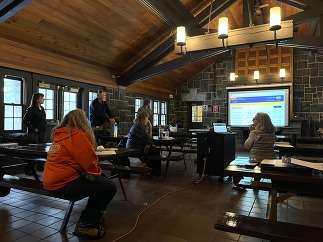
The Civilian Conservation Corps developed the initial park infrastructure, including the River Inn in the late 1930s and early 1940s.
Today, more than 100 years of park use has created newer, meaningful connections between visitors and the park, which mingle with the importance this area retains for the Tribal members who continue to visit, exercise their treaty rights, and share historical and contemporary cultural insights with park visitors and staff. Partnership efforts are now focused on the mutual interest in respectful stewardship and sharing the land.
The coming together of these points in time made the park the perfect place for the Minnesota Department of Natural Resources Tribal Relations Work Team’s recent meeting. A place to reconcile the past with the present to move forward, collaboratively, into the future.
The team supports the Minnesota DNR’s mission to protect, conserve and manage natural resources for the benefit of all the state’s residents and visitors, with a focus on advancing the agency’s strategic priority of consulting and collaborating with Tribal governments, developing training related to native nations and native governance, and tracking issues and topics which arise in communications from Tribal governments to the Minnesota DNR.
The agenda for the all-day Dec. 5 work team meeting ranged from brief updates on the development of tribal resources webpages, staff positions to support the work of the team, and the tribal contact form; to larger discussions about how to communicate about the Native people who lived within the Minnesota’s boundaries before it was a state.
“Each piece of land is going to have a different story,” Tribal Relations Director Bradley Harrington said.
A significant part of this team’s work is promoting the consultation and coordination with Tribal governments prescribed in statute – and forming relationships between the state and Tribal governments.
Jay Cooke State Park Manager Lisa Angelos said park staff are working more and more with the nearby Fond du Lac Band of Lake Superior Chippewa.
“We’re trying to do whatever we can to enhance those relationships and look for opportunities and make friends, basically,” Angelos said.
This has included invitations to state park events, drumming and cultural exhibits, native themes in naturalist programs, and collaborations in the environmental review process. A soon-to-launch example is a multilingual signage project about river animals, featuring Ojibwe language and cultural content as well as graphics from an Indigenous artist. The project took multiple years but doing collaboration right takes time, Angelos said.
“I think fear stops people (from collaborating),” Angelos said. “Just be real and be ready to not be trusted the way you’d like to be because there’s a lot tied to what you represent…it’s a lengthy process for any relationship, but you have to invest.”
For more information: Tribal Relations at DNR
|
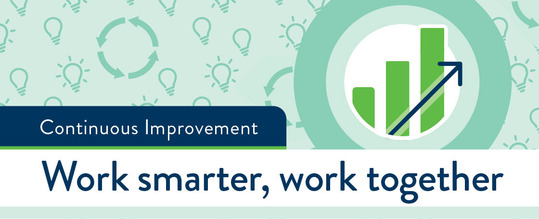
Learning and networking opportunities are available to all DNR and MNIT at DNR employees through our agency membership with the Performance Excellence Network (PEN).
The DNR’s membership includes free access to one-hour online professional development seminars to support staff development in improvement methods and innovation.
DNR Continuous Improvement staff host a debrief session on Teams following each seminar for DNR employees to network and discuss application to our work. Our employees are also eligible for a discount on day-long workshops and conferences offered by PEN.
You can request to join the DNR Continuous Improvement group on Microsoft Teams to receive notifications and registration details of seminars and other continuous improvement learning opportunities.
Next seminar is Jan. 25: Want Accountability? Start with Empathy.
Optional networking begins at 7:45 a.m., seminar starts at 8 a.m..
You can register by selecting “Member Event Fee – Online - $0.00” in the registration form.
Or join the session through the link posted on our Continuous Improvement group on Microsoft Teams prior to the session.
This session will cover:
- Three proven methods for holding others accountable.
- Simple ways to build trust.
- Best practices for giving and receiving feedback.
- Tips for staff retention.
Recordings of past sessions are available anytime in the on-demand library. A sample of past seminars have focused on the following topics: effective communication in changing work environments, managing change, best practices in managing a team, increasing resiliency under stress, and mitigating unconscious bias.
Contact Laura Grunloh or Yengmy Thao with any questions.
When you use strong passwords, you reduce the ability for cyber criminals to compromise the state systems and devices that we rely upon to provide services for all Minnesotans.
Did you know that as technology advances, it is easier for seasoned cybercriminals to crack your password? According to the Hive Systems Password Tables (below), using cloud computing to crack passwords in 2023 shows how quickly simple passwords can be breached. According to the Federal Trade Commission’s consumer advice to create strong passwords, “aim for at least 12 characters.”
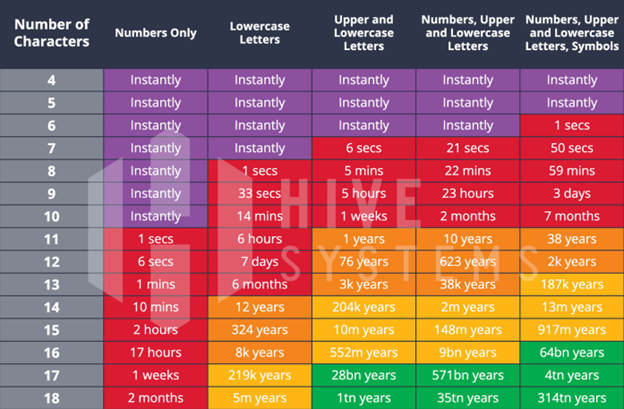 Figure 1 - Time to crack MD5 hash using 8 A100 GPUs from Amazon AWS (from Hive Systems)
Create strong, unique passwords to protect state systems
A weak password creates a risk for you and an opportunity for cyber criminals to target personal and state data to steal information, commit identity theft, and infect devices.
“Even with all the technical advances in the world and the number of cybersecurity protections installed on state systems, one thing has stayed the same: bad passwords. Six of the worst passwords of 2017 are still in use in 2022 (see the lists below). This is alarming because we know that 82% of data breaches use hacked usernames or passwords, phishing attacks, errors, or misuse of information.” (Source: 2022 Verizon Data Breach Investigations Report)
 Password managers are a great option for securing your passwords. Install your agency-approved password manager - KeePass.
- Go to the Windows start button on the taskbar.
- Search for the Software Center.
- Select applications.
- Select KeePass and install.
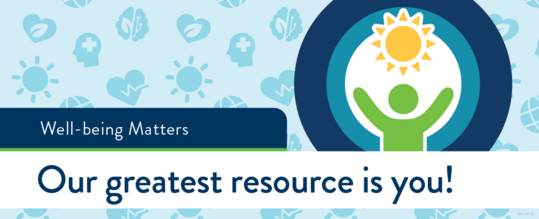
The Organizational Health Team’s Well-being Action Team is hosting two presentations in January. These presentations may be attended on work time. They will not be recorded. A summary of topics discussed will be made available on the Well-being Intranet page following the sessions.
Parental Leave Presentation
Thursday, Jan. 11, 1-2 p.m. (open to all employees)
Use this Teams link to join the meeting or contact Gratia Joice or Laura Grunloh to receive the meeting appointment.
Join human resources and the Well-being Action Team’s New Parents Group to learn about parental leave at the DNR. The DNR’s FMLA Leave Coordinator, Melissa Galvan, will provide a general overview relating to parental leave (for both birthing and non-birthing parents), including:
- Family Medical Leave Act (FMLA) HR/LR Policy #1409
- Paid Parental Leave HR/LR Policy #1435
- Labor Contracts and Pay Plans : Parenthood Leave of Absence
- MN Pregnancy and Parenting Leave
- Pregnant Workers and New Parents (DLI)
The presentation will be followed by a Q&A. Submit questions by Tuesday, Jan. 9 via this anonymous form.
Mental well-being skills and tools for supervisors and managers
Thursday, Jan. 18, noon (open to supervisors and managers)
An optional meeting invite was sent to all managers and supervisors on Tuesday,
Nov. 28. Contact Laura Grunloh if you missed it. Submit questions in advance via the link in the meeting appointment. This agenda will be refined to address questions received.
- Human Resources Director Denise Legato will share tips for risk management and engaging with an employee when you sense they might be going through a hard time. Denise will explain how the supervisor is expected to be a link to resources, but counseling staff is out of scope.
- Steven Reuter, consultant with Leadership and Team Dynamics (formerly Resolve EAP), will explain Employee Assistance Program resources for managers and supervisors and tips on sharing resources with employees.
- The Well-being Action Team will explain resources in development for supervisors to use with their work teams (presentations about EAP resources, examples of how employees have used EAP, talking points, etc.)
Questions? Contact Laura Grunloh or any Well-being Action Team member.
For more info: Well-being intranet webpage.
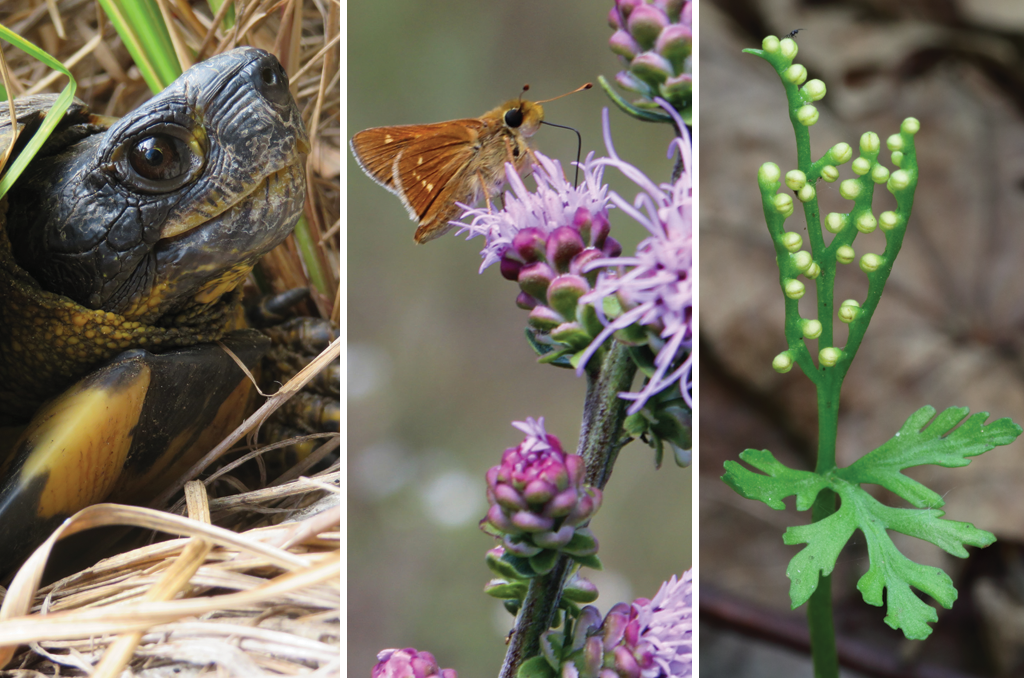
The Minnesota DNR would like you to take this short survey to help the DNR build improvements in the Rare Species Guide. The guide is the most complete, single source for information on Minnesota's endangered, threatened and special concern animals and plants.
With just under 600 individual species profiles, this essential guide is consulted by natural resource professionals, contractors, researchers, and the public alike.
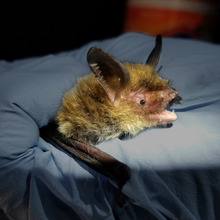
Each species profile contains a variety of information, including species descriptions, habitat, conservation and management assessments, and why the species is rare. Penned by some of Minnesota’s most-knowledgeable authorities, every account is peer reviewed and underpinned by data that is updated on a bi-weekly basis.
This guide makes finding info on your favorite rare plant or rare animal easy; navigation of the Rare Species Guide is powered by key word, A-Z list, and a suite of filtered searches, including selection by taxonomic group, status, county, Ecological Classification System (ECS) subsection, watershed, and/or habitat.
However, the guide (first launched in 2008) can still be improved. Whether you’re a regular visitor to the Rare Species Guide – or are just discovering it today – we’d like to hear from you! Information gleaned from the survey will help us make the Rare Species Guide even better.
Thank you for contributing to the Rare Species Guide.
|
An announcement has been posted on the self-service announcements page reminding DNR employees of the advantages of receiving their W-2 electronically.
- Electronic W-2 information is available several days prior to the date they are mailed.
- Employees also can obtain historical W-2 information.
- Providing W-2’s saves time on reprint requests.
- An electronic W-2 keeps personal information confidential and will not be lost or delayed by the mail.

If you’re looking to connect with your coworkers and bond with fellow book lovers, check out the Fans of Fiction book club!
The book club began in 2020 as an opportunity for DNR employees to virtually get together and have discussions not related to work. The club reads one fiction book a month. Employees use break times to attend the monthly meetings, which are held from noon to 1 p.m.
Since its inception, the book club has read 36 fiction books in a variety of genres, including: Where the Crawdads Sing by Delia Owens, Station Eleven by Emily St. John Mandel, Homegoing by Yaa Gyasi, Parable of the Sower by Octavia Butler, How High We Go in the Dark by Sequoia Nagamatsu, The Light Between Oceans by M.L. Stedman, and more.
In January, the club will discuss their favorite books they read in 2023. For the rest of 2024, the club will be reading:
- Lessons in Chemistry by Bonnie Garmus
- How Beautiful We Were by Imbolo Mbue
- Trust by Hernan Diaz
- Girl, Woman, Other by Bernardine Evaristo
- The Tattooist of Auschwitz by Heather Morris
- Eleanor Oliphant is Completely Fine by Gail Honeyman
- The Plague of Doves by Louise Erdrich
- The Sympathizer by Viet Thanh Nguyen
- The Martian by Andy Weir
- Demon Copperhead by Barbara Kingsolver
- A Tale for the Time Being by Ruth Ozeki
For more information about the book club or to join, email Maggie Snyder.

There’s no doubt the ice fishing season hasn’t gone as planned for many anglers across the state. The calendar says one thing, but Mother Nature says another. In recent days, conservation officers have spent plenty of time warning people about ice conditions (where there is ice), checking on shelters and other equipment that have fallen through, and taking part in rescues of stranded ice anglers.
Following are highlights from the past two weeks.
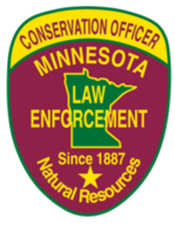
Dec. 26, 2023
CO Jamus Veit (Baudette East) spent time checking anglers on Upper Red Lake and Lake of the Woods. Anglers are having a lot of success catching limits on Lake of the Woods. Veit assisted the Beltrami County Sheriff's Office and Kelliher Fire Department with an ice rescue on Upper Red Lake. With the warmer weather and rain, Veit wants to urge anglers to use caution when venturing out onto the ice. Enforcement action was taken for an extra-line violation, allowing a minor to violate game and fish laws, and taking a walleye overlimit.
CO Matthew Brodin (Brainerd) spoke to a local news station regarding the new litter law. A reminder for anglers to not place trash, cigarette filters or any other waste directly onto the ice. With the warmer weather and rain this week the ice is likely deteriorating. If you venture onto the ice please check every couple feet to make sure you are on safe ice. Enforcement action was taken for multiple license-related issues.
CO Garrett Thomas (Eagan) continued to work on an ongoing background investigation. Additionally, Thomas spent time checking field goose hunters and assisting surrounding states with follow-up investigations related to the deer season. Career interviews were also given to local students working on school projects related to conservation.
Jan. 2, 2024
CO Ben Huener (Roseau) and CO Fontes assisted Lake of the Woods County with the recovery of a drowning victim at the Northwest Angle. Anglers were checked later in the week on the south shore of Lake of the Woods. The bite has slowed, and ice conditions are changing. Violations for the week included angling with an extra line and angling without a license.
CO Thomas Wahlstrom (Grand Marais #1) worked the BWCAW trout opener with area officers. Travel was fast with the lack of snow and good ice. He assisted with a rope rescue of a person who fell close to 50 feet into the Cross River gorge. Assistance was given to the county and State Patrol with a stop for fleeing in a motor vehicle.
The following are several highlights from the weekly Conservation Office reports
|

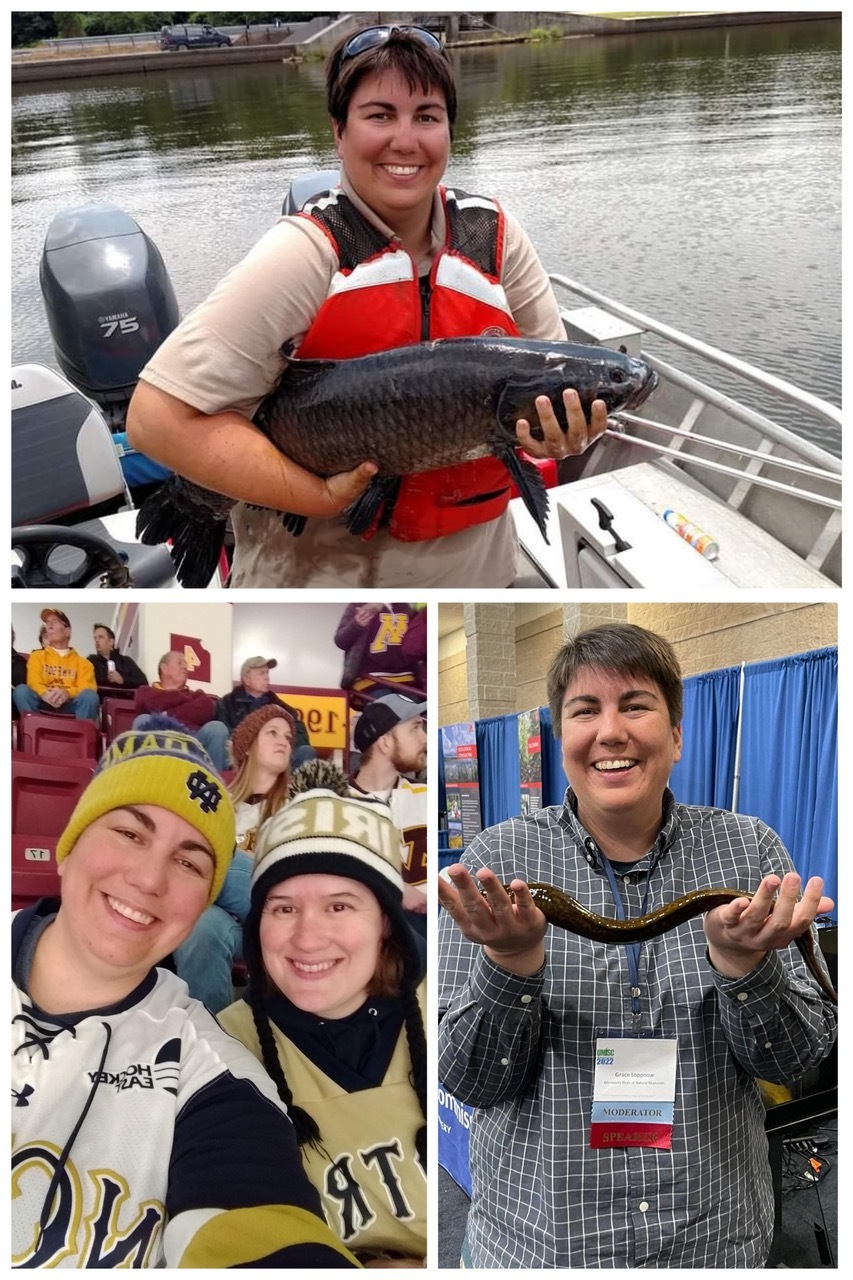 By Greg Husak, information officer, Ecological and Water Resources Division
Grace Loppnow has deep experience with invasive carp. The DNR invasive fish coordinator found her way back to Minnesota and her current role after years of research and prevention work in national hotbeds of invasive carp activity.
“During my undergrad program at Notre Dame, I started working on invasive species projects, and that really got me interested in this field,” said Loppnow who earned a Ph.D. at the University of Minnesota Twin Cities in conservation biology. Her dissertation project included working on invasive fish issues. Grace also got a minor in risk analysis for introduced species.
From there, she landed an internship with the U.S. Fish and Wildlife Service, working on risk assessments for invasive species at their headquarters in Washington, D.C. After that, she took a job with the Fish and Wildlife Service, working on invasive carp in southern Illinois. There, she started the Black Carp Working Group.
She learned a lot about the importance of partnerships through early projects like the working group she established.
“It's a multi-agency and university partnership of many different folks that work on black carp, all trying to get the information they need," she said.
Grace then became deputy program lead at the U.S. Fish and Wildlife Service in the Green Bay office, where she worked on an early detection and monitoring program that involved some traditional methods and eDNA sampling for invasive carp. That brought her here to Minnesota and her current role with the DNR.
"I feel deeply invested in this issue, and I’m glad I can bring the expertise I've gathered at these other positions back to Minnesota to help in our prevention and management of invasive carp," Loppnow said.
Along with partnerships, Grace said a wide range of prevention and management techniques and tools must be coupled with a proactive approach.
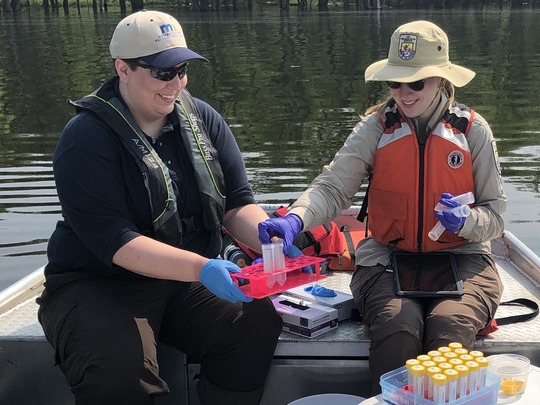 Loppnow (left) takes eDNA samples with staff from U.S. Fish and Wildlife Service.
“Invasive carp are tenacious and hardy species. We need to keep learning, sharing our information, and applying a variety of tools in an integrated approach. We saw the effectiveness of that with the recent capture of 323 invasive carp in Pool 6 of the Mississippi River. That involved teamwork with the Wisconsin DNR, federal agencies and our contracted fishers. It also employed the tagged fish that we have used to track invasive carp movements.”
Grace added that she’s looking forward to implementing a new invasive carp action plan, scheduled for release soon, that came out of a structured decision-making process with more than a dozen agencies and organizations all sharing their ideas and experiences.
"It’s really a team effort on a national scale," she said. "No one agency or single technique can do it all.”
 Title: Invasive fish coordinator, DNR Ecological and Water Resources Division
Joined the DNR: August 2021
Work location: St. Paul Central Office
Education: Bachelor of Science, Biology, University of Notre Dame. Ph.D., Conservation Biology, Minor in Risk Analysis in Introduced Species and Genotypes, University of Minnesota Twin Cities.
Fun fact: “My partner Maria and I enjoy getting out in nature to go fishing and forage for mushrooms. I love foraging and gardening. The family business growing up was a flower shop and greenhouse, so I really connect with growing things.”

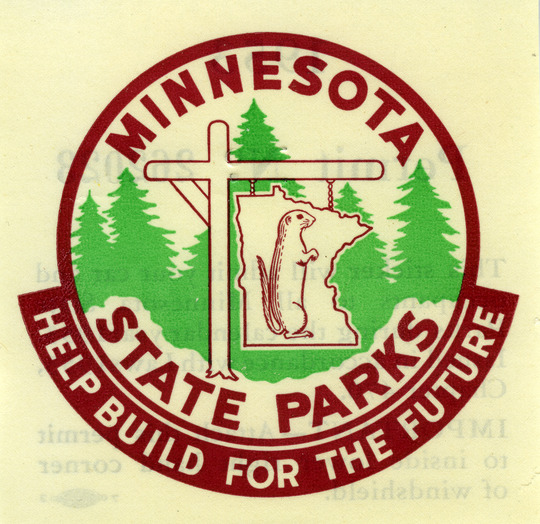 Flashback: This is the first Minnesota state parks sticker which debuted in 1953. It cost $1 and featured a gopher that appears to be as large as the state. Up until 1983, a specific park was not featured on park permits each year. Many of those designs listed the permit year and “MINNESOTA STATE PARKS.” In other cases, specific parks were noted as well as the permit year and year of park establishment.
|